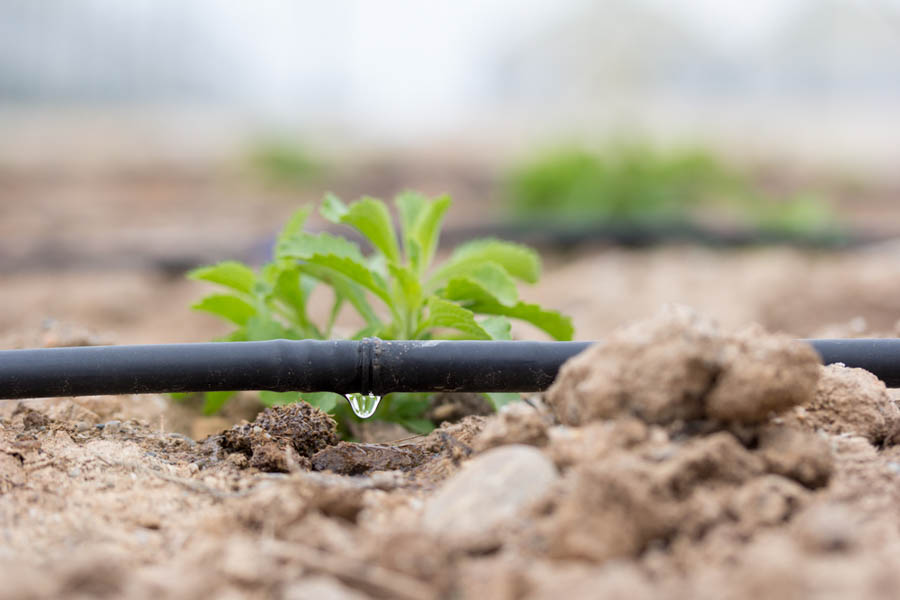New Year's Resolution: Water Plants and Trees Deeply

New Year’s Gardening Resolution 3: Water Plants and Trees Deeply.
GardenZeus receives commissions for purchases made through links in this post. There is no additional cost to you.
“How often and how much do plants and trees need to be watered?” is both one of the simplest and most-complex questions for gardeners.
The simple answer is that most plants should be watered to the entire depth of their roots, then not watered again until soil dries out to some degree, which varies by species.
The complex answer involves many factors and variables, including plant species, soil texture, and seasonal temperatures.
Sprinklers are useful for watering lawns and some small bedding plants, but are unsuited to watering almost all other plants and trees.
Reasons to avoid shallow, frequent irrigation:
– Plant roots grow where the water is. Shallow, frequent watering over time concentrates roots, even for large trees, in the top few inches of soil, where they may dry out rapidly and need frequent watering. Roots near the soil surface are most susceptible to pests, diseases, and injury.
– Spray irrigation or frequent wetting of stems and foliage encourages pests, diseases, and weeds.
– Shallow water results in greater evaporation with negative results, including faster accumulation of soil salts as minerals in municipal water are left behind in soil as water evaporates.
Slow, deep watering has many possible benefits including:
– Deeper, firmer rooting for trees and shrubs. Deeper roots increase a plant’s drought tolerance.
– Reduced evaporation and runoff.
– Reduction in pests, diseases, and weeds.
– Potential reduction in water use.
To water deeply, use a drip system or a trickle from a hose at a rate slow enough to prevent runoff. Many larger garden plants and landscape shrubs will benefit from slow watering for several minutes to an hour or two depending on plant size, soil texture, and watering rate/volume.
Learning to water your established trees and large shrubs takes time and observation. Irrigation volume and frequency vary by species and plant size. Observe shrubs and trees for early signs of drought stress, such as slight curling or drooping of leaves, then water deeply. If established trees need water again sooner than a few weeks, increase watering duration and/or volume.
In California Mediterranean-climate areas, many large shrubs and trees should be watered only once every few-to-several weeks during warm weather, and less often during cold weather, especially with occasional winter rainstorms. Trees should be watered at or just inside the dripline (the edge of the canopy).
Water penetration in soil can be evaluated by pressing a long screwdriver or thin metal probe into soil and noticing when soil resistance changes as dry soil is reached. This method can be used to gauge how fast water infiltrates to a foot or two in depth for a given method of irrigation. A shovel can also be pressed carefully into the soil outside or at the edge of an established plant’s root system to expose the soil profile and gauge depth of roots. For gardeners who want more precision and less guesswork, GardenZeus recommends a professional quality moisture meter inserted at the edge of the root system. (Picture below.)
Water spreads as it infiltrates into soil, narrowly in sandy soils and more widely in clay soils. If it takes your drip system or a trickle from your hose 1 hour to deliver water to a foot in depth in clay soil, it’s a reasonable guess that it should take about 6 to 8 hours of watering using the same method to deliver water to 4 to 5 feet in depth for a larger tree.
GardenZeus has customized gardening information by plant and zip code. To get started, click here.
Other articles of interest:
Rain! Rain! Rain! But is it Enough to Water Plants?
Chlorine, Soil, and Watering Gardens (Chlorinated Water, Part 1 of 2)
Remove Chlorine When Watering Organic Gardens (Chlorinated Water, Part 2 of 2)
